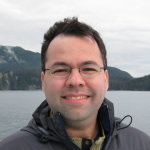SCEC Broadband Platform for Ground Motion Simulation and Validation
The SCEC Broadband Platform (BBP) is a collection of open-source codes used to simulate broadband (0-20+ Hz) ground motions for historical and scenario earthquakes. A team of SCEC researchers including scientists, engineers, and computer scientists develop, verify, and validate the scientific models and analysis codes in the platform and then release them as open-source software. The latest Broadband Platform release, version 19.8.0, is available for download on GitHub.
The BBP software modules implement kinematic rupture generation, low- and high-frequency seismogram synthesis using 3D wave propagation through 1D layered velocity structures, non-linear site effects, ground motion intensity measure calculations, and visualization tools. The current boundary limit between low and high frequencies, for methods that use an hybrid approach is 1 Hz. These complex scientific codes have been carefully integrated into a system that supports easy on-demand computation of broadband seismograms, providing user-defined, repeatable calculation of ground-motion seismograms, using alternative simulation methods, and software utilities to generate comparison tables, plots, and maps. The SCEC BBP is designed to be used by both geophysicists and engineering researchers with some experience interpreting ground motion simulations.
 |
| Sample slip distribution generated on the SCEC Broadband Platform for a three-segment simulation of the M7.2 1992 Landers earthquake. |
Users may use the SCEC BBP to calculate broadband seismograms for both historical earthquakes and user-defined scenario earthquakes. There are currently seven simulation methods implemented in the BBP and any of them can be run using the same set of text input files for the source and velocity models to be used. The SCEC Broadband Platform currently includes a collection of 21 historical events (13 in California, 4 in Japan, 3 in Eastern North America, and 1 in Italy), with readily available recordings at selected stations that can be used to validate simulation methods and/or input parameters.
| Left: List of scientific methods available in the SCEC Broadband Platform. Each simulation method is created by combining a specific set of scientific modules. Right: The GP method (as example) includes a rupture generator, low and high-frequency modules, and site response module. |
 |
When running a validation event, users can supply their own simple source description (basic geometry, rake, magnitude, dip, etc.), or provide a rupture description in SRF format if they have one. The BBP then produces a variety of data products, including broadband seismograms, rupture plane visualizations, and several goodness-of-fit plots comparing simulations and recorded data by spectral period, distance, and on maps. The simulation results also include a comparison to empirical ground motion models. This validation mode allows modelers to develop, test, and calibrate their simulation methods and enables users to compare results across multiple simulation methods. To run new scenarios (not one of the 21 validation events), users can select the scenario mode and supply their own stations.
The SCEC BBP software can be compiled and run on Linux systems using open-source compilers and libraries. It features an interactive command-line interface that guides users through the process of setting up validation or scenario simulation runs. Capabilities also include the ability for users to automate the simulation setup steps through scripts, making it easier and efficient supporting the submission of sets of simulations to computer clusters.
Our latest available Broadband Platform distribution, version 19.8.0, is a Python 3 port of our previous 19.4.0 release, and includes the seven simulation methods, ten simulation regions for which 1D velocity models have been developed, covering California, Japan, Italy, Eastern North America, and the ability to compare simulation results against empirical ground motion models. The latest release includes the ability to simulate multi-segment ruptures using several of the available simulation methods. It also provides two alternate site response modules that can be used with any of the simulation methods and for both the validation and scenario simulations.
The SCEC Broadband Platform is under active development and continues to evolve, with new versions released periodically on GitHub.
About the Authors
 |
Fabio Silva is a SCEC computer scientist at the University of Southern California. He is the lead developer of the SCEC Broadband Platform and collaborates with scientists from several research institutions in order to integrate scientific codes into the SCEC Broadband Platform. |
 |
Philip Maechling is the Associate Director for Information Technology for the Southern California Earthquake Center, where he develops and performs large-scale seismic hazard calculations using high performance computing. He also develops and releases open-source seismological and engineering software used in ground motion modeling and simulations. |
 |
Christine Goulet is the Executive Director for Applied Science at the Southern California Earthquake Center. She serves as the science lead and technical integrator for large-scale collaborative projects involving diverse disciplines related to earthquake hazard and risk. |
Acknowledgements
This research was supported by the Southern California Earthquake Center with additional support provided by the Pacific Gas and Electric Company. SCEC is funded by NSF Cooperative Agreement EAR-1600087 and USGS Cooperative Agreement G17AC00047.
References
- The SCEC Broadband Platform is available on GitHub.
- Maechling, P. J., F. Silva, S. Callaghan, and T. H. Jordan (2015). SCEC Broadband Platform: System Architecture and Software Implementation, Seismol. Res. Lett., 86, no. 1, doi: 10.1785/0220140125
- Goulet, C.A., Abrahamson, N.A., Somerville, P.G. and K, E. Wooddell (2015) The SCEC Broadband Platform Validation Exercise: Methodology for Code Validation in the Context of Seismic-Hazard Analyses, Seismol. Res. Lett., 86, no. 1, doi: 10.1785/0220140104
- Dreger, D. S., Beroza, G.C., Day, S. M., Goulet, C. A., Jordan, T. H., Spudich, P. A., and Stewart, J. P. (2015). Validation of the SCEC Broadband Platform V14.3 Simulation Methods Using Pseudospectral Acceleration Data, Seismol. Res. Lett., 86, no. 1, doi:10.1785/0220140118.



